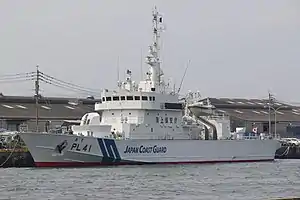 Aso (PL 41) | |
| Class overview | |
|---|---|
| Name | Aso class |
| Builders | Mitsubishi Heavy Industries, Universal Shipbuilding Corporation |
| Operators | |
| Preceded by | Ojika class |
| Succeeded by | Hateruma class |
| Subclasses | TT-1500 design |
| Built | 2002–2006 |
| In commission | 2005–present |
| Planned | 3 |
| Completed | 3 |
| Active | 3 |
| Class overview | |
| Name | TT-1500 design |
| Builders | TBA |
| Operators | |
| Preceded by | |
| Cost | USD $398,430,000 for six vessels |
| Built | Jul. 2020 - Oct. 2026 (planned) |
| Planned | 6 |
| On order | 6 |
| Completed | 0 |
| Active | 0 |
| General characteristics (Aso class) | |
| Type | 1,000 ton-class PL (Patrol vessel, Large) |
| Tonnage | 770 GT |
| Length | 79.0 m (259 ft 2 in) |
| Beam | 10.0 m (32 ft 10 in) |
| Depth | 6 m (19 ft 8 in) |
| Propulsion |
|
| Speed | 30+ knots |
| Complement | 30 |
| Armament | One Bofors 40 mm L/70 gun with optical FCS |
| Armour | Ballistic protection over certain areas |
| Aviation facilities | One helipad (TT-1500) |
| General characteristics (TT-1500) | |
| Type | General-purpose TT (tuần tra)-classification offshore patrol vessels |
| Displacement | 1,500 ton |
| Length | 79.0 m (259 ft 2 in) |
| Beam | 11.0 m (36 ft 1 in) |
| Height | 6.8 m (22 ft 4 in) (freeboard) |
| Draught | 3.3 m (10 ft 10 in) |
| Speed | 24 knots (44 km/h; 28 mph) |
| Range | 4,000 nautical miles (4,600 mi; 7,400 km) |
| Armament |
|
| Aviation facilities | One helipad |
| Notes | Characteristics extracted from the 2018 initial projection and likely become subjects to be changed |
The Aso-class patrol vessel is a class of PL type patrol vessel of the Japan Coast Guard. PL stands for Patrol vessel Large, and the class is named after Mount Aso, the largest active volcano in Japan.
This class is one of the new patrol vessel classes to intercept spy boats of DPRK. These classes are called "高速高機能大型巡視船", High-speed, high-functionality patrol vessel, large. Having Bofors 40 mm L/70 autocannon with fire-control system, this class is safely able to deal with heavily armed spy boats of DPRK which intrude into Japanese waters. The hull of this class is bulletproof in case of close-range firefights.
In the back of the bridge's side, this class has display devices that can be used to instruct other ships to stop even at nighttime. And on the bridge superstructure, this class is equipped with the LIDAR system to acquire targets with high accuracy. At the same time, this system enables them to perform search and rescue missions more safely.
Vietnamese variant
In 2020 there was signed an export deal between Japan and Vietnam over 6 vessel for the Vietnam Coast Guard (VCG), locally designated as the "TT-1500 patrol ship".[1][2]"TT" stands for "Tuần tra" means "Patrol", meanwhile the number "1500" stands for the class's displacement of 1500 tons. According to pieces of information shared by VCG, TT-1500 has a slightly bigger size than the original Aso-class, and it is also equipped with a helipad and the overall design is likely inspired from the successor designs such as the Kunigami-class patrol vessel.
The TT-1500 will have a maximum speed of 24 knots, considerably slower than the original Aso, however it is projected to have a better low-speed stability hence making it better for low-intensity patrol and search-and-rescue missions.[3] The delivery for all 6 ships is expected to be completed by October 2026.[4]
Ships in the class
| Pennant number | Ship name | Builder | Commission | Homeport |
|---|---|---|---|---|
| PL 41 | Aso | Mitsubishi Heavy Industries | 15 March 2005 | Fukuoka |
| PL 42 | Dewa | Universal Shipbuilding Corporation | 12 April 2006 | Akita |
| PL 43 | Hakusan | Kanazawa | ||
| CSB 8*** | TBA | |||
See also
- List of Japan Coast Guard vessels and aircraft
- Hida-class patrol vessel - another class of High-speed, high-functionality patrol vessel, large.
References
- ↑ "Japan to build six patrol vessels for Vietnam's Coast Guard". 8 August 2020.
- ↑ "Vietnam Coast Guard". www.globalsecurity.org. Retrieved 22 July 2021.
- ↑ "[ẢNH] Cảnh sát biển Việt Nam có thêm lớp tàu tuần tra cỡ lớn hiện đại". Báo điện tử An ninh Thủ đô (in Vietnamese). 1 September 2018. Retrieved 18 November 2023.
- ↑ "Ex-Ante Evaluation (for Japanese ODA Loan)" (PDF). JICA.
Further reading
- "Ships of Japan Coast Guard". Ships of the World. Kaijinn-sha (692): 51. July 2008.
- Shigehiro Sakamoto (July 2008). "60th Anniversary of JCG: For near future". Ships of the World. Kaijinn-sha (692): 132–137.
- Yoshifumi Mayama (July 2008). "60th Anniversary of JCG: Technical history of its ship". Ships of the World. Kaijinn-sha (692): 138–143.